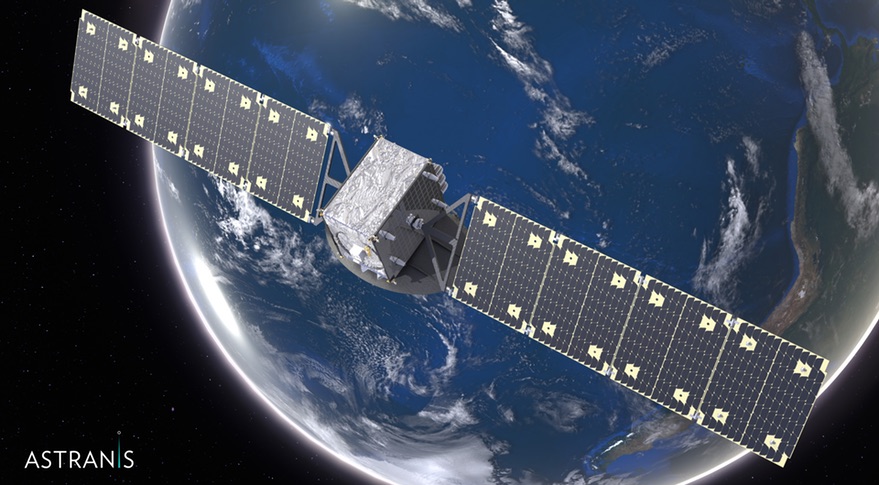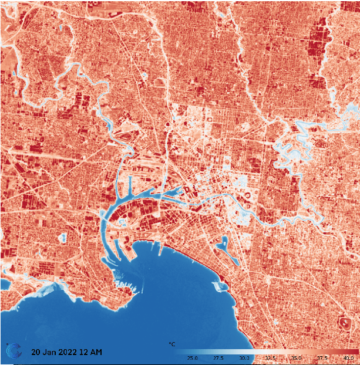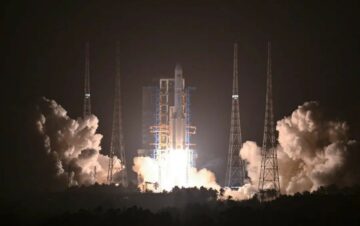
TAMPA, Fla. — Astranis is moving its debut satellite to a geostationary position over Asia after a malfunction last year derailed plans to beam broadband to Alaska, the Californian manufacturer said Feb. 27.
Arcturus set off Feb. 1 and should arrive by the middle of March, Astranis CEO John Gedmark told SpaceNews, where it will spend three months to satisfy Israeli operator Spacecom’s reservation for the orbital slot under international regulatory rules.
The companies did not disclose the orbital slot, Spacecom’s plans for the position, or the operator’s so-called Bring-into-Use deadline with the International Telecommunication Union (ITU), an arm of the United Nations.
Financial details about the arrangement are also undisclosed.
Spacecom currently operates four satellites providing broadcast and broadband services over parts of Europe, the Middle East, Africa, and Asia: Two at four degrees West, one at 17 degrees East, and another at 65 degrees East.
Successfully securing a new position that would extend the operator’s reach into Asia would be “a pivotal milestone for Spacecom,” its CEO Dan Zajicek said in an emailed statement without elaborating.
Repurposed mission
Helping an operator secure orbital rights is a very different mission than what Astranis had initially envisaged for the 400-kilogram, dishwasher-sized satellite, launched April 30 as a secondary payload on a SpaceX Falcon Heavy rocket.
The failure of two onboard solar array drive assemblies shortly after launch means Arcturus is unable to keep solar arrays pointed at the sun for consistent power.
Astranis can only get six to 12 hours of service a day from Arcturus — not enough for an earlier plan to lease the spacecraft to Pacific Dataport so the Alaskan telco could provide at least 7.5 gigabits per second (Gbps) of regional throughput in Ka-band.
But the satellite is otherwise in good health, according to Gedmark, and has the maneuverability and fuel to be able to do dozens of relocation maneuvers over its seven-year design life.
He said the satellite is currently speeding along the geostationary arc at a transfer altitude of about three degrees of longitude per day.
The satellite’s digital radio processor is also operating at full capability, enabling the spacecraft to send different signals with a software upload from the ground. This capability is key to satisfying ITU orbital reservation rules that require an operator to place a satellite in the slot for three months with the capability of transmitting and receiving assigned radio frequencies.
“Arcturus is fully capable of meeting all regulatory requirements,” Gedmark said via email, “including operating across the full range of frequency bands.”
He said Astranis plans to move Arcturus back over Alaska, at 163 degrees West, at some point after the Spacecom mission for activities that include testing and technology demonstrations.
Arcturus has already helped U.S. government customers perform end-to-end connectivity demonstrations since its original mission was sidelined, as well as test advanced waveforms and ground equipment.
“The Arcturus satellite is in high demand for a number of missions,” he added.
Meanwhile, Astranis is building a replacement for Pacific Dataport that is slated to launch on an undisclosed dedicated rocket in 2025 as part of a batch of five satellites, collectively called Block 3.
Gedmark said the issue with the solar array drive assemblies, used to position solar panels in orbit and one of a small portion of spacecraft Astranis does not build in-house, has been fully diagnosed and fixed for future satellites.
Four Block 2 broadband satellites that were set to launch last year before Arcturus’s issues are now in an integration and testing phase, he added, ahead of plans to launch them on a dedicated SpaceX Falcon 9 rocket this year.
Block 2 comprises the Agila satellite for Orbits Corp of the Philippines, a pair of spacecraft for U.S.-based mobile satellite connectivity specialist Anuvu, and UtilitySat, which will initially serve as a partial replacement for Arcturus over Alaska.
Only three customers have been disclosed for Block 3 so far: A second satellite for Orbits Corp and two for Mexican telco Apco Networks.
- SEO Powered Content & PR Distribution. Get Amplified Today.
- PlatoData.Network Vertical Generative Ai. Empower Yourself. Access Here.
- PlatoAiStream. Web3 Intelligence. Knowledge Amplified. Access Here.
- PlatoESG. Carbon, CleanTech, Energy, Environment, Solar, Waste Management. Access Here.
- PlatoHealth. Biotech and Clinical Trials Intelligence. Access Here.
- Source: https://spacenews.com/astranis-relocating-hobbled-debut-satellite-from-alaska-to-asia/
- :has
- :is
- :not
- :where
- 1
- 12
- 17
- 2%
- 2025
- 27
- 30
- 5
- 65
- 7
- 9
- a
- Able
- About
- According
- across
- activities
- added
- advanced
- africa
- After
- ahead
- alaska
- All
- along
- already
- also
- an
- and
- Another
- April
- Arc
- ARE
- ARM
- arrangement
- Array
- arrive
- AS
- asia
- assigned
- At
- back
- BE
- Beam
- been
- before
- Block
- broadband
- broadcast
- build
- Building
- by
- called
- CAN
- capability
- capable
- ceo
- collectively
- Companies
- comprises
- Connectivity
- consistent
- Corp
- could
- Currently
- Customers
- dan
- day
- deadline
- debut
- dedicated
- Demand
- Design
- details
- DID
- different
- digital
- Disclose
- do
- does
- dozens
- drive
- Earlier
- East
- enabling
- end-to-end
- enough
- equipment
- Europe
- extend
- falcon
- Falcon 9
- far
- Feb
- five
- fixed
- fla
- For
- four
- Frequency
- from
- Fuel
- full
- fully
- future
- get
- good
- Government
- Ground
- had
- Have
- he
- Health
- heavy
- helped
- High
- HOURS
- HTTPS
- in
- include
- initially
- integration
- International
- International Telecommunication Union
- into
- Israeli
- issue
- issues
- IT
- ITS
- John
- jpg
- Keep
- Key
- Last
- Last Year
- launch
- launched
- least
- Life
- Manufacturer
- March
- means
- meeting
- Middle
- Middle East
- milestone
- Mission
- missions
- months
- move
- moving
- Nations
- New
- now
- number
- of
- off
- on
- Onboard
- ONE
- only
- operates
- operating
- operator
- or
- Orbit
- original
- otherwise
- over
- Pacific
- pair
- panels
- part
- partial
- parts
- per
- perform
- phase
- Philippines
- pivotal
- Place
- plan
- plans
- plato
- Plato Data Intelligence
- PlatoData
- Point
- portion
- position
- power
- Processor
- provide
- providing
- Radio
- range
- reach
- receiving
- regional
- regulatory
- replacement
- require
- Requirements
- reservation
- rights
- rocket
- rules
- s
- Said
- satellite
- satellites
- satisfy
- Second
- secondary
- secure
- securing
- send
- serve
- service
- Services
- set
- Shortly
- should
- signals
- since
- SIX
- slot
- small
- So
- so Far
- Software
- solar
- solar panels
- some
- spacecraft
- SpaceX
- specialist
- spend
- Statement
- Sun
- Technology
- Telco
- telecommunication
- test
- Testing
- than
- that
- The
- The Philippines
- Them
- this
- this year
- three
- throughput
- to
- told
- transfer
- two
- u.s.
- U.S. government
- unable
- under
- union
- United
- united nations
- used
- very
- via
- was
- WELL
- were
- West
- What
- which
- will
- with
- without
- would
- year
- zephyrnet










